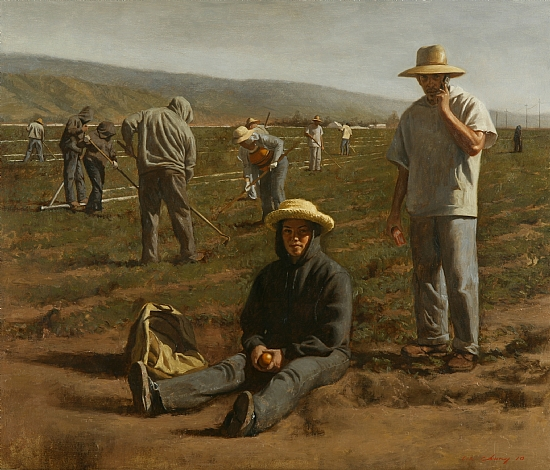
The painting of the famous contemporary American artist Warren Chang “Fall Tilling” is exhibited in the Monterey Museum of Art. This narrative artwork, painted in 2010, depicts typical agricultural workers who are tilling the soil in Monterey County, California. This portrayal of common people doing their daily work in the field is lifelike thanks to the masterful transmission of light and subdued tones. This artwork is painted in the style of realism, and perfectly conveys the emotions and mood of ordinary farmers.
The artist has managed to perfectly convey the picturesque view of labor. The painting depicts fall tilling in rural California. People work under the fall sun that is merciless, so they wear straw hats and cover their heads with hoods. In the foreground, a peasant girl is depicted sitting on the ground and having a rest. She is beautiful and her features radiate calmness and confidence. Nearby, there is a backpack from which she has just taken out an apple. A man stands next to her and speaks on the phone. Thanks to the image of modern clothes and a mobile phone, one can see that the artist depicts modern people. In the distance, other peasants can be seen plowing the soil to improve its condition for the harvest. Particular attention is paid to the experiences of the depicted characters. Perhaps, the artist was fascinated by the intense, persistent work of these strong, resilient people, their thoughts, unhurried work, and great patience.
The mood is created in this lifelike painting by manipulating light and using muted colors. There are no bright and diverse colors in the picture, but pastel and soft shades. The artist specifically uses these tones to show the calm, pastoral life of the peasants, without the city’s variegation and bustle. The main colors are muted green, brown, as well as light and dark shades of gray. The palette of this painting tends to dark, earthy, and natural tones. Warm colors create the impression of an autumn season with a burning sun, which does not allow workers to hide for even a minute. An endless, calm, light gray sky stretched over the horizon. A hilly landscape is visible in the distance, and there is much space around. Pale grass creates a mood of calm fall afternoon fatigue.
Nature is not used as a simple decoration, but the rural landscape is a reflection of a certain state of farmers’ inner world. In this artwork, as in all pastorals, soft atmosphere, indirect lighting, and the calmness of a rural landscape are visible. The oil paints are slightly washed out to show the search for balance through the integration of figures into an environment where people and nature coexist in perfect harmony. The artist uses oil to depict even the smallest details to add to better realism. The figures of the peasants are well-painted, even every fold in their clothes and shoes can be seen. Their strong hands and well-balanced figures speak of their strength and agility. The artist faithfully and objectively reproduces reality in all its details.
The painting glorifies the work and endurance of the peasants, as well as the happiness of life in the vastness of their native land. He celebrates nature that gives all its blessings to a free working man and brings abundance and wealth to everyone. This artwork also praises friendly teamwork, which requires coordination, physical stress, skill, and dexterity. This painting that depicts work on earth immortalized on the canvas is of great importance. By showing simple farmers working under the scorching sun, the artist has proved that the rural labor, dictated by the rising and setting of the sun, as well as the changing seasons, is extremely important. It is valuable even in the modern world of innovation and technology.
This realistic canvas, executed in the classical technique, reminds the artists of the 19th century, in particular Francois Millet, who often painted scenes from peasant life. Warren Chung’s interest in this style of painting is also rooted in the work of the 16th-century artist Jan Vermeer. His artworks are appreciated by lovers of traditional painting and are recognized at the national level. Warran Chung’s work “Fall Tilling” is not a heroic depiction of the working class, but a realistic illustration of ordinary people doing their work. This is a kind of exploration of modern rural life which Warren Chang sees around without any exaggeration.
Everyday life and the modern world have become suitable objects for art, designed to accurately and objectively capture reality. In Warran Chung’s artwork “Fall Tilling”, created in the style of realism, the artist does not use idealistic images, but, on the contrary, a real event from farmers’ lives. He touches upon numerous social and cultural aspects, painting them without embellishment. Therefore, he gives great significance to ordinary peasants, their daily life, and their work in the field. The desire to bring everyday life into his canvas has become a manifestation of the artist’s desire to combine art and life.